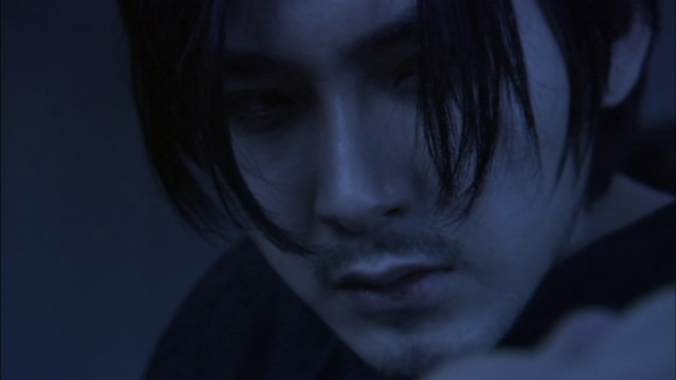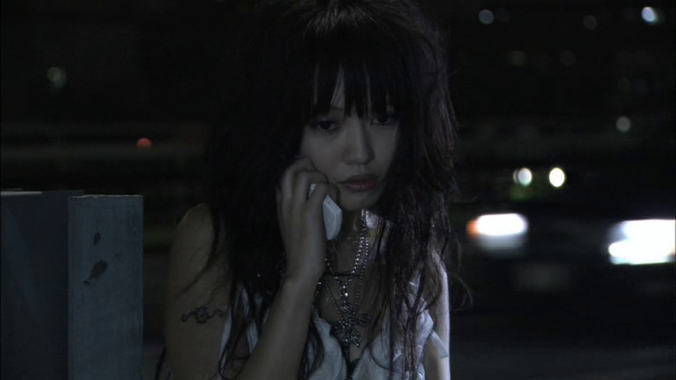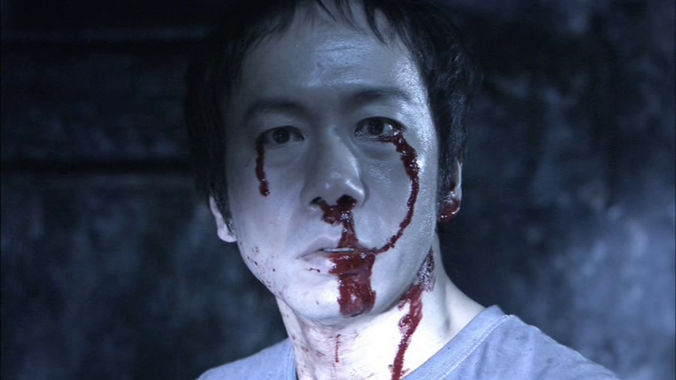 We first meet Kagenuma, the Nightmare Detective (Ryuhei Matsuda), with an in joke about J-Horror itself. He has entered the nightmares of Oishi, an old man who keeps a long black wig on the wall and seems to be haunted by it. Kagenuma explains the nightmares, but Oishi prefers to stay in the dream world and dies. Kagenuma is so overwhelmed with his powers that enable him not only to enter the dreams of others but to hear their inner thoughts that he himself attempts suicide to escape.
We first meet Kagenuma, the Nightmare Detective (Ryuhei Matsuda), with an in joke about J-Horror itself. He has entered the nightmares of Oishi, an old man who keeps a long black wig on the wall and seems to be haunted by it. Kagenuma explains the nightmares, but Oishi prefers to stay in the dream world and dies. Kagenuma is so overwhelmed with his powers that enable him not only to enter the dreams of others but to hear their inner thoughts that he himself attempts suicide to escape.
In the meantime, a woman on the street says she wants to commit suicide together with the man on the phone but changes her mind when she hears the man stab himself.  Something pursues her on her way home and she is found in pools of blood the next morning. Police want to dismiss it as a simple suicide, but Keiko thinks there is something more. She is new to the team of detectives, though experienced in the fraud squad. Her suspicion is confirmed when a man commits suicide in bed with his wife, constantly slashing at his throat while asking for help. Both victims have made their last phone call to a mysterious 0. While the rest of the team try to track down 0 by normal means, she is sent to look for the Nightmare Detective, finding him just after his own suicide attempt. He refuses to help until the young detective Wakamiya also commits suicide in the police station after reaching 0 on the phone. Keiko calls 0, which is a real danger since she is haunted my another version of herself, and this leads Kagenuma, Keiko, and 0 into a whirl of their own dreams, nightmares, and repressed memories.
Something pursues her on her way home and she is found in pools of blood the next morning. Police want to dismiss it as a simple suicide, but Keiko thinks there is something more. She is new to the team of detectives, though experienced in the fraud squad. Her suspicion is confirmed when a man commits suicide in bed with his wife, constantly slashing at his throat while asking for help. Both victims have made their last phone call to a mysterious 0. While the rest of the team try to track down 0 by normal means, she is sent to look for the Nightmare Detective, finding him just after his own suicide attempt. He refuses to help until the young detective Wakamiya also commits suicide in the police station after reaching 0 on the phone. Keiko calls 0, which is a real danger since she is haunted my another version of herself, and this leads Kagenuma, Keiko, and 0 into a whirl of their own dreams, nightmares, and repressed memories.
Because it is directed by Shunya Tsukamoto, Nightmare Detective becomes far more than just another horror film. Though the internet and cell phone of J-Horror make their appearance, they are only a means to an end, not the source of the evil, which lies in suppressed memories and emotions which Tsukamoto sees as common to almost everyone in Japanese society. The frenzied phone call of the woman takes place on a sidewalk, not in her apartment, while traffic drives by, completely ignoring her situation. Though Keiko and Kagenuma survive the experience, we can hardly say they are cured, as would occur in an American version of such a story.
After the wig on the wall in the first scene, no spirit personified by a girl with long hair ever makes an appearance. Obviously, any movie with a killer who works through dreams will bring to mind the Nightmare on Elm Street franchise, but 0 (played by Tsukamoto himself) is no Freddy Krueger. He seeks no revenge but genuinely wants to kill himself. This doesn’t work because he is revitalized each time someone else dies, his wounds mysteriously healing themselves. Or maybe not, for while he seems active, he is also seen dying in a hospital bed with bloody bandages on his stomach and a phone in his hand.
He seeks no revenge but genuinely wants to kill himself. This doesn’t work because he is revitalized each time someone else dies, his wounds mysteriously healing themselves. Or maybe not, for while he seems active, he is also seen dying in a hospital bed with bloody bandages on his stomach and a phone in his hand.
One of the striking aspects of suicide in Japanese movies is that it is rarely a solitary event. People seem to try to hang themselves alone – Kagenuma even tries it – but even hara-kiri is a public event. Suicides that use poison or knives tend to want to be accompanied into the afterlife. When there is no romantic couple to commit a love suicide, they search for someone else, sometimes simply a person with the same urges. 0 has advertised on the internet that he wants to commit suicide but wants someone to die with him, and the people who call him initially want that same sense of doing it together, even if they have never met the other person. The girl in the street is so desperate that we really believe it is her lover that she is talking to and are quite surprised to find eventually that it is a total stranger. And there is no doubt that 0 has seriously stabbed himself when she is talking to him.
The most mysterious part of 0’s phone calls, however, is that recordings of them indicate the voice of a little girl crying for help after 0 has stopped talking. That will eventually turn out to be the repressed memory of 0’s life.
Using a mix of HD and 35mm, Tsukamoto makes no visual distinction between dreams and reality.
The tints of scenes change constantly. Bright sunlight is rare, but we spend most of our time in scenes of blues, golds, denatured color, and sometimes pure black and white. As with most Tsukamoto movies, there are an enormous number of editing cuts in 90 minutes. The supposedly “normal” scenes are more disorienting than the dream sequences, for they often take place in fully frontal shots, expressionless as in a Kitano movie, and several scenes in a moving car seem intentionally artificial. In particular, this leaves Keiko (the model and singer Hitomi) without a clearly defined characterization. We never know why she has transferred to street crimes, and we never quite connect the figure that haunts her (herself in a red dress) to the rest of the dreams.
There is a hint of parody of the whole police and horror genre. The policemen are right out of the stereotype handbook — one old hand (Ren Osugi) and his friendly young partner (Masanobu Ando) who are assigned Keiko, the new intellectual type who thinks everybody else is wrong and is a woman besides. The killer from afar is standard now in not only the Elm Street franchise but also most of the landmarks of J-Horror. But Tsukamoto seems uninterested in the horror effects per se, though we do see a remarkable amount of blood for his films and we also see a number of empty hallways while the victim hurries away from an imaginary threat. All of the victims contact 0 intentionally, unlike the victims in most other J-Horror films who are selected by the spirit, and there is no attempt to provide shock for its own sake. The memories involved are about death, but not about monsters or revenge-seekers.
One of Tsukamoto’s most consistent themes has been the repression of true emotions, but here he is not concerned with sexual repression in any way. More important are the repressed memories that he had explored in Vital. Oddly enough, this makes it seem a bit more like a conventional horror movie, for the assumption is that once we can confront and accept those memories we can get on with a better life. Yet Kagenuma remains unconvinced that such a thing is possible in the epilogue. This would lead to a sequel also by Tsukamoto in 2008 but without Keiko that would eventually explain the memory that haunted Kagenuma. Even so, Tsukamoto seems to be more concerned with the experience of the dreams than the content of them, and though it is not as dreamlike as his shorter Haze, the dream sequences are as incoherent yet as real as dreams.



